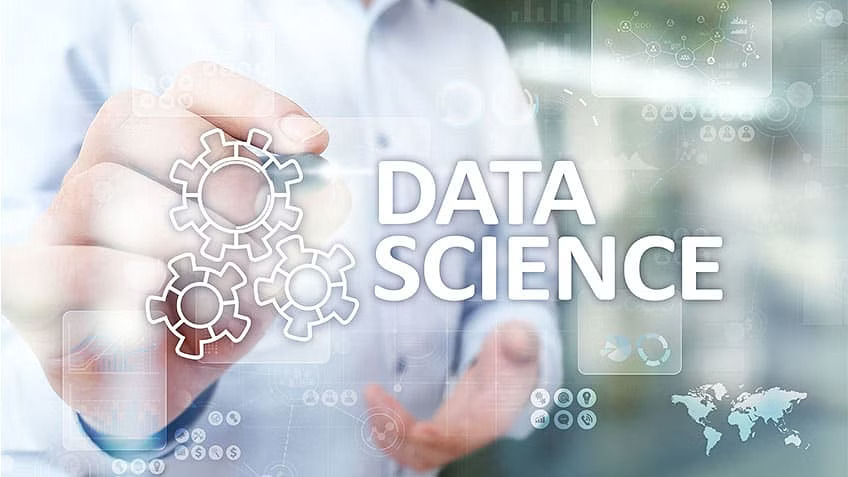In today’s data-driven era, where information is generated at an unprecedented rate, data science has emerged as a vital tool for extracting valuable insights from vast amounts of data. So, what is data science anyway?
In this blog, we’ll take you on an exciting adventure through the realm of data science, demystifying its key concepts, methodologies, and applications. Whether you’re a seasoned data professional, an aspiring data scientist, or simply someone intrigued by the power of data, this article will provide you with a comprehensive understanding of data science and its real-world implications and show you how to become get into the field through an online data science course.
What is Data Science?
Data science, in simple terms, refers to the interdisciplinary blend of scientific methods, algorithms, and systems used to analyze, interpret, and derive meaningful patterns and trends from raw data. It combines elements of mathematics, statistics, computer science, and domain expertise to uncover hidden patterns, make predictions, and drive informed decision-making across various industries and sectors.
A Short History of Data Science
The history of data science is a captivating journey that reflects the evolution of technology, statistical methods, and the growing importance of data in various domains. Here are some key milestones in the history of data science in the United States:
- Early Beginnings: The origins of data science can be traced back to the mid-20th century when pioneers like John W. Tukey and Norbert Wiener laid the foundation for statistical analysis and information theory. Their work formed the basis for understanding the principles of data and its application in scientific research.
- Rise of Computers: With the advent of computers in the 1960s and 1970s, data analysis shifted from manual calculations to automated processes. The development of programming languages like FORTRAN and COBOL enabled data scientists to manipulate and analyze large data sets more efficiently.
- Emergence of Data Warehousing: In the 1980s, the concept of data warehousing gained prominence. Data warehousing allowed organizations to store, integrate, and analyze vast amounts of structured and unstructured data, paving the way for more sophisticated data analysis techniques.
- Big Data Revolution: The 21st century witnessed an explosion of data due to the rise of the internet, social media, and technological advancements. This marked the era of big data, where data scientists faced the challenge of processing and extracting insights from massive datasets.
- Machine Learning and AI: In recent years, machine learning and artificial intelligence (AI) have become integral components of data science. Advancements in algorithms, computational power, and deep learning techniques have enabled data scientists to build complex models for predictive analytics, natural language processing, computer vision, and more.
- Industry Adoption: Data science has gained widespread recognition and adoption across industries, including finance, healthcare, marketing, and technology. Organizations now rely on data scientists to derive actionable insights, improve decision-making processes, and drive innovation.
The history of data science showcases its continuous evolution and transformative impact on various industries. As we move forward, data science is poised to revolutionize further how we interpret, utilize, and extract value from the ever-expanding world of data.
Also Read: A Data Scientist Job Description: The Roles and Responsibilities in 2023
What is Data Science Used For?
Data science is a multi-faceted discipline with many applications across diverse industries and sectors for various purposes, leveraging the power of data to drive innovation, inform decision-making, and solve complex problems. Let’s look at some ways industries are leveraging data science are some key applications of data science.
- Business Analytics: Data science is crucial in understanding consumer behavior, optimizing operations, and driving business growth. Businesses can make informed decisions about product development, marketing strategies, pricing, and resource allocation by analyzing customer data, market trends, and sales patterns.
- Healthcare and Biomedicine: Data science transforms the healthcare industry by enabling personalized medicine, predictive analytics, and disease prevention. Analyzing medical records, genomic data, and clinical trials helps identify risk factors, develop treatment protocols, and improve patient outcomes.
- Finance and Banking: The financial sector heavily relies on data science for risk assessment, fraud detection, and algorithmic trading. Data scientists can develop models for credit scoring, portfolio management, and identifying potential risks by analyzing market trends, economic indicators, and customer data.
- Social Media and Marketing: Data science is pivotal in social media analytics, helping businesses understand user behavior, sentiment analysis, and targeted advertising. By leveraging social media data, companies can enhance their marketing strategies, engage with customers effectively, and drive brand awareness.
- Transportation and Logistics: Data science is utilized to optimize transportation networks, improve route planning, and enhance supply chain management. Data scientists can develop algorithms to minimize delivery times, reduce costs, and optimize resource allocation by analyzing data from sensors, GPS devices, and historical records.
- Environmental Science: Data science aids in analyzing environmental data to address climate change, natural resource management, and sustainable development. By leveraging data from satellites, weather stations, and environmental sensors, scientists can model and predict climate patterns, monitor ecosystem health, and develop strategies for environmental conservation.
- Government and Public Policy: Governments increasingly use data science to make data-driven policy decisions, improve public services, and enhance governance. Analyzing socioeconomic data, census data, and public health records enables policymakers to identify societal challenges, allocate resources effectively, and measure the impact of policy interventions.
These are just a few examples of the vast applications of data science. From improving customer experiences to advancing scientific research, data science continues to revolutionize various sectors by harnessing the power of data and unlocking valuable insights for a better future.
What’s the Difference Between Business Intelligence and Data Science?
While business intelligence (BI) and data science share similarities in their data utilization, key distinctions exist between the two disciplines. Understanding these differences is crucial for organizations seeking to leverage data effectively. Here’s a brief overview of how business intelligence and data science differ:
Business intelligence focuses on gathering, analyzing, and visualizing data to provide insights into past and current business performance. It primarily deals with structured data from internal systems such as sales, finance, and customer relationship management. BI tools and techniques enable organizations to generate reports, dashboards, and key performance indicators (KPIs) for monitoring and reporting on operational metrics.
On the other hand, data science encompasses a broader and more exploratory approach to data analysis. It involves extracting insights and generating predictive models by leveraging statistical techniques, machine learning algorithms, and domain expertise. Data science incorporates structured and unstructured data from various sources, including internal systems, external APIs, social media, and sensor data.
Key Characteristics of Business Intelligence
- Historical Analysis: BI predominantly focuses on historical data analysis to identify trends, patterns, and performance metrics.
- Structured Data: BI relies on structured data from databases and data warehouses, often sourced from internal systems.
- Reporting and Visualization: BI tools excel at generating reports, dashboards, and visual representations of data for business users to understand and monitor key metrics.
Key Characteristics of Data Science
- Predictive and Prescriptive Analytics: Data science aims to uncover actionable insights, make predictions, and drive informed decision-making using advanced analytical techniques.
- Unstructured and Big Data: Data science deals with structured and unstructured data, including text, images, and sensor data. It embraces the challenges and opportunities presented by big data.
- Algorithm Development and Optimization: Data scientists develop and optimize algorithms to solve complex problems, build predictive models, and extract insights from data.
In summary, while business intelligence focuses on reporting historical data and monitoring key performance metrics, data science goes beyond that, using statistical and machine learning techniques to uncover patterns, predict future outcomes, and enable data-driven decision-making. Both disciplines are valuable in their own right, with business intelligence offering operational insights and data science providing more advanced analytics and predictive capabilities for strategic decision-making.
What is Data Science, and What Does the Data Science Life Cycle Look Like?
Data science projects involve a systematic approach encompassing various components and following a typical life cycle. Understanding a data science project’s key elements and stages is essential for successful implementation. Here’s an overview of the components and the typical life cycle of a data science project:
- Data Collection: The first step in a data science project is collecting relevant data from various sources. This includes structured data from databases, unstructured data from text documents or social media, and external data from APIs or web scraping.
- Data Cleaning and Preprocessing: Once the data is collected, it must be cleaned and preprocessed to ensure its quality and consistency. This involves removing duplicates, handling missing values, standardizing formats, and transforming data into a suitable format for analysis.
- Exploratory Data Analysis (EDA): Exploratory Data Analysis involves understanding and summarizing the data through statistical techniques, data visualization, and descriptive analytics. EDA helps identify patterns, relationships, and potential outliers, providing insights into the data’s characteristics.
- Feature Engineering: Feature engineering is the process of selecting, creating, or transforming variables (features) to enhance the predictive power of a model. It involves techniques such as scaling, dimensionality reduction, and creating new features from existing ones.
- Model Development: This phase involves selecting appropriate modeling techniques, such as statistical models or machine learning algorithms, based on the project’s objectives. The data scientist builds and trains models using the prepared data and evaluates their performance using validation techniques.
- Model Evaluation and Validation: Models must be validated to ensure their accuracy, robustness, and generalizability. This involves testing the models on unseen data, comparing performance metrics, and fine-tuning the models as necessary.
- Deployment and Implementation: Once a model has been developed and validated, it must be deployed into production systems or integrated into existing workflows. This often involves collaboration with software engineers or IT teams to ensure smooth integration and scalability.
- Monitoring and Maintenance: After deployment, models must be monitored to ensure they perform well over time. Monitoring involves tracking model performance, data drift, and making necessary adjustments or updates to maintain optimal performance.
Data science projects are iterative, with feedback and insights from each stage influencing subsequent stages. The life cycle may vary depending on the project’s complexity and specific requirements, but this general framework provides a foundation for successful data science project management.
Also Read: Data Scientist vs. Data Analyst – The Differences Explained
What Skills Do Data Scientists Need?
Data scientists require a unique blend of technical expertise and non-technical skills to excel in their roles. Here’s a breakdown of the essential technical and non-technical skills that data scientists need:
Data Scientist Technical Skills
- Programming: Proficiency in programming languages such as Python, R, or SQL is crucial for data manipulation, analysis, and model development. A solid understanding of programming concepts and the ability to write efficient and maintainable code are essential.
- Data Manipulation and Analysis: Data scientists should be skilled in data manipulation and analysis using libraries and frameworks like pandas, NumPy, and dplyr. These tools enable data cleaning, transformation, exploratory data analysis, and statistical modeling.
- Machine Learning: Understanding and applying machine learning algorithms and techniques are key skills for data scientists. This includes knowledge of algorithms like linear regression, decision trees, random forests, support vector machines, and neural networks, as well as familiarity with libraries like scikit-learn and TensorFlow.
- Statistical Analysis: Proficiency in statistical concepts and methods is crucial for data scientists. They should have a solid foundation in hypothesis testing, regression analysis, time series analysis, and experimental design to draw meaningful insights from data.
- Data Visualization: Data scientists should be skilled in creating effective visualizations to communicate insights and findings. They should be familiar with visualization libraries like Matplotlib, ggplot2, or Tableau to create clear and compelling visual representations of data.
Data Scientist Non-Technical (Soft) Skills
- Analytical Thinking: Data scientists must possess strong analytical skills to approach complex problems, break them into manageable components, and develop data-driven solutions. They should have a keen eye for detail and the ability to think critically.
- Domain Knowledge: A solid understanding of the domain or industry they are working in is crucial. Data scientists must grasp the nuances and context of the data they analyze to develop meaningful insights and make relevant recommendations.
- Communication: Data scientists should be able to effectively communicate their findings and insights to both technical and non-technical stakeholders. Strong written and verbal communication skills are essential to present complex concepts clearly and understandably.
- Problem-Solving: Data scientists need to be skilled problem solvers, capable of approaching challenges creatively and systematically. They should have a logical mindset and the ability to devise innovative approaches to tackle complex data problems.
- Collaboration: Data scientists often work in multidisciplinary teams, collaborating with domain experts, software engineers, and business stakeholders. Strong teamwork and interpersonal skills are necessary to work effectively in a collaborative environment and leverage collective expertise.
- Continuous Learning: Data science is a rapidly evolving field, and data scientists must be proactive in keeping up with the latest trends, techniques, and tools. They should have a thirst for knowledge and a commitment to lifelong learning to stay ahead in this dynamic field.
By combining technical prowess with non-technical skills, data scientists can navigate the complexities of data analysis, model development, and stakeholder engagement to deliver impactful results in their organizations.
What Are Some of the Best Data Science Tools?
Data science relies on various tools for data analysis, model development, and visualization. Here are some commonly used data science tools in the American context.
- Programming Languages:
- Python: Widely adopted for its versatility, Python offers a rich ecosystem of libraries and frameworks such as NumPy, pandas, scikit-learn, and TensorFlow, making it a popular choice for data manipulation, analysis, and machine learning.
- R: Specially designed for statistical computing and graphics, R provides a comprehensive set of packages for data exploration, visualization, and statistical modeling.
- Integrated Development Environments (IDEs):
- Jupyter Notebook/JupyterLab: These web-based interactive environments support code execution, data visualization, and documentation in a single environment, making them ideal for exploratory data analysis and sharing results.
- RStudio: A powerful IDE for R, offering a user-friendly interface, code editing, debugging, and package management features tailored for R development.
- Data Visualization:
- Tableau: A popular data visualization tool that allows users to create interactive dashboards, charts, and reports without requiring extensive coding knowledge.
- Matplotlib: A widely-used plotting library for Python that provides a range of visualization options for creating static, animated, or interactive visual representations of data.
- Machine Learning and Statistical Modeling:
- scikit-learn: A machine learning library for Python that offers various algorithms for classification, regression, clustering, and dimensionality reduction tasks.
- TensorFlow: An open-source library providing a flexible ecosystem for building and deploying machine learning models, particularly deep learning applications.
- caret: A comprehensive package in R that offers a unified interface for training and evaluating machine learning models.
- Data Manipulation and Analysis:
- pandas: A powerful data manipulation library for Python that provides flexible data structures and data analysis tools, enabling efficient data cleaning, transformation, and aggregation.
- dplyr: A widely-used package in R that offers a concise and intuitive syntax for data manipulation tasks, providing functions for filtering, arranging, summarizing, and joining data.
- Big Data Processing:
- Apache Spark: A fast and distributed data processing engine that supports big data processing and analytics, offering scalability and compatibility with multiple programming languages.
These are just a few examples of the tools commonly utilized in data science projects. The choice of tools depends on specific project requirements, personal preferences, and the data science community’s current trends and best practices.
What is Data Science, and What Are the Pros and Cons?
Data science offers exciting opportunities and has gained immense popularity due to its potential for driving data-driven decision-making and innovation. However, like any field, there are pros and cons you should consider while pursuing a career in data science:
Pros of a Data Science Career
- High Demand and Lucrative Salaries: Data scientists are in high demand across industries, which is expected to continue growing. As a result, data scientists often enjoy competitive salaries and ample job opportunities.
- Solving Complex Problems: Data science allows professionals to tackle complex problems and make sense of vast amounts of data. It allows applying advanced analytics, machine learning, and statistical techniques to drive insights and find innovative solutions.
- Impactful Work: Data science enables professionals to make a significant impact by leveraging data to inform decision-making, optimize processes, improve products and services, and drive business outcomes. Data scientists have the potential to drive meaningful change and innovation within organizations.
- Continuous Learning and Growth: Data science is a rapidly evolving field, offering continuous learning and professional growth opportunities. New techniques, algorithms, and tools emerge regularly, allowing data scientists to stay updated and expand their skill sets.
Cons (and Challenges) of a Data Scientist Career
- High Expectations and Pressure: Data scientists often face high expectations and pressure to deliver actionable insights within tight deadlines. Data analysis and modeling demand for accuracy and quality can create a challenging and stressful work environment.
- Data Quality and Accessibility: Data scientists frequently encounter issues with data quality, including missing values, inconsistencies, and biases. Obtaining and accessing relevant data can be a significant challenge, requiring collaboration with data engineers and domain experts.
- Interdisciplinary Skills Required: Data science requires proficiency in technical and non-technical skills. This field’s interdisciplinary nature means data scientists need to continually develop and refine their expertise in programming, statistics, domain knowledge, and communication skills.
- Ethical Considerations: Working with sensitive data and making decisions based on statistical models and algorithms raises ethical concerns. Data scientists must grapple with issues like privacy, bias, and fairness to ensure data’s responsible and ethical use.
- Rapid Technological Changes: The fast-paced nature of data science means that staying up to date with the latest tools, techniques, and algorithms is crucial. Keeping pace with rapidly evolving technologies can be challenging, requiring continuous learning and adaptation.
Despite the challenges, the opportunities and rewards in data science make it an exciting and promising career path for those passionate about data analysis, problem-solving, and innovation. By recognizing and navigating the potential drawbacks, data scientists can maximize their impact and contribute to the data-driven transformation of industries and society.
Also Read: All About Data Scientist Salaries
What Job Opportunities Can Data Scientists Expect?
Data scientists are in high demand across various industries as organizations recognize the value of data-driven insights and decision-making. Here’s an overview of the job opportunities for data scientists and industries actively hiring them in the American context:
Job Opportunities for Data Scientists
- Data Scientist: The role of a data scientist involves analyzing complex datasets, developing predictive models, and deriving insights to solve business problems. Data scientists apply statistical and machine learning techniques to extract valuable information from data.
- Machine Learning Engineer: Machine learning engineers focus on developing and implementing machine learning models and algorithms. They work closely with data scientists to deploy and optimize models for real-world applications.
- Data Analyst: Data analysts focus on data exploration, visualization, and statistical analysis to derive insights and support decision-making. They often use structured and semi-structured data to identify trends, patterns, and correlations.
- Data Engineer: Data engineers are responsible for building and maintaining the infrastructure and pipelines needed to handle large-scale data processing. They design and develop systems to collect, store, and transform data, ensuring its availability and reliability.
- Business Intelligence Analyst: Business intelligence analysts leverage data to provide insights and support strategic decision-making within an organization. They develop reports, dashboards, and visualizations to communicate data-driven insights to stakeholders.
Industries Hiring Data Scientists
- Technology and Software: Technology companies, including software development firms, data analytics providers, and tech startups, rely heavily on data scientists to develop innovative solutions, optimize processes, and improve user experiences.
- Healthcare: The healthcare industry increasingly leverages data science to enhance patient care, optimize operations, and conduct medical research. Data scientists play a crucial role in areas such as personalized medicine, clinical trials, disease prediction, and healthcare analytics.
- Finance and Banking: Banks, financial institutions, and insurance companies hire data scientists to analyze financial data, detect fraud, develop risk models, and optimize investment strategies. Data scientists help improve decision-making and enhance customer experiences in the financial sector.
- Ecommerce and Retail: Data science has become essential in the e-commerce and retail sectors for personalized marketing, customer segmentation, demand forecasting, inventory optimization, and pricing strategies. Data scientists help businesses understand consumer behavior and drive revenue growth.
- Manufacturing and Supply Chain: Manufacturers and supply chain companies utilize data science to optimize production processes, improve supply chain efficiency, and reduce costs. Data scientists analyze operational data, identify bottlenecks, and develop predictive maintenance models.
- Energy and Utilities: Data scientists play a significant role in the energy and utilities industry by optimizing energy distribution, predicting equipment failure, and improving energy efficiency. They help companies make informed decisions for sustainable energy practices.
- Government and Public Sector: Government agencies and public sector organizations hire data scientists to analyze public data, conduct policy research, and optimize service delivery. Data scientists support evidence-based decision-making and drive innovation in the public sector.
These are just a few examples of industries actively hiring data scientists. However, data science skills are increasingly sought after across a wide range of sectors as organizations recognize the potential of data-driven insights to gain a competitive edge and drive growth.
A Career in Data Science Is Achievable
If you’re interested in becoming a data scientist, there are several paths you can take to gain the necessary skills and qualifications. Here are some steps you can follow:
- Understand What Data Science Is: Before diving into the field. Data science is a multidisciplinary field that combines statistics, mathematics, programming, and domain expertise to extract insights and make data-driven decisions. Familiarize yourself with the core concepts, methodologies, and techniques by exploring online resources, books, and courses covering data science fundamentals.
- Acquire a Solid Foundation in Mathematics and Statistics: Data science heavily relies on mathematical and statistical principles. Enhance your knowledge in areas such as calculus, linear algebra, probability, and statistics. Understanding these concepts will enable you to develop and apply models, analyze data, and draw meaningful insights.
- Learn Programming Languages: Proficiency in programming languages is essential for data science. Start by learning Python or R, which are widely used in the data science community. Explore online tutorials, coding bootcamps, or university courses to gain hands-on experience writing code, data manipulation, and analysis.
- Gain Hands-on Experience with Data: Practice working with real-world datasets to build your skills. Seek out publicly available datasets or participate in Kaggle competitions to apply data manipulation, exploratory data analysis, and modeling techniques. Working on projects will give you a deeper understanding of data science methodologies and help you gain valuable experience.
- Take Data Science Courses and Certifications: Consider enrolling in data science courses or pursuing certifications. Numerous online platforms, universities, and bootcamps offer data science programs covering machine learning, data visualization, and data engineering. These courses provide structured learning and help you build a solid foundation in data science concepts and tools.
- Engage in Practical Projects and Internships: Apply your knowledge to practical projects and seek out internships or industry projects that allow you to work on real-world data problems. Practical experience will enhance your technical skills and provide valuable insights into how data science is applied in different industries.
- Stay Curious and Keep Learning: Data science is a rapidly evolving field, so it’s crucial to stay curious and keep up with the latest trends, techniques, and tools. Follow industry blogs, join online communities, attend webinars, and participate in data science competitions to stay updated and continuously enhance your skills.
Remember, the path to becoming a data scientist is a journey that requires dedication, continuous learning, and hands-on practice. By building a strong foundation in mathematics, programming, and statistics while gaining practical experience in a data science bootcamp, you can pave the way toward a successful career in data science.
Read More: How to Become a Data Scientist in 2023?
FAQs
What is Data Science?
Data science is the interdisciplinary blend of scientific methods, algorithms, and systems that analyze, interpret, and derive meaningful patterns and trends from raw data. It combines elements of mathematics, statistics, computer science, and domain expertise to uncover hidden patterns, make predictions, and drive informed decision-making across various industries and sectors.
Why is Data Science Important?
Data science is important because it empowers organizations to make data-driven decisions, optimize operations, enhance customer experiences, predict future trends, and drive scientific advancements. By harnessing the power of data, data science provides a competitive edge, promotes innovation, and improves overall decision-making processes across various domains.
What is Data Science Useful For?
Data science is incredibly useful for a wide range of applications. It helps extract meaningful insights from vast amounts of data, enabling data-driven decision-making and problem-solving. Data science is used to optimize business processes, enhance customer experiences, develop predictive models, improve healthcare outcomes, drive scientific research, detect fraud, analyze social media sentiments, and much more. Data science empowers organizations to leverage data effectively and derive actionable insights that improve efficiency, innovation, and informed decision-making.
What are Some of the Downsides of Data Science?
While data science offers numerous benefits, it also comes with its downsides. Some challenges include the potential for biased results due to skewed data or flawed algorithms, ethical concerns related to data privacy and security, the complexity of handling large and messy data sets, and the continuous need to keep up with rapidly evolving technologies and techniques. Additionally, data science projects can be time-consuming, resource-intensive, and may require significant computational power. The pressure to deliver accurate insights within tight deadlines can also contribute to a high-stress work environment. It’s important for data scientists to be aware of these downsides and address them appropriately to ensure the responsible and effective use of data science methodologies.
You might also like to read:
A Complete Cybersecurity Job Description
What is Azure DevOps? A Complete Guide






